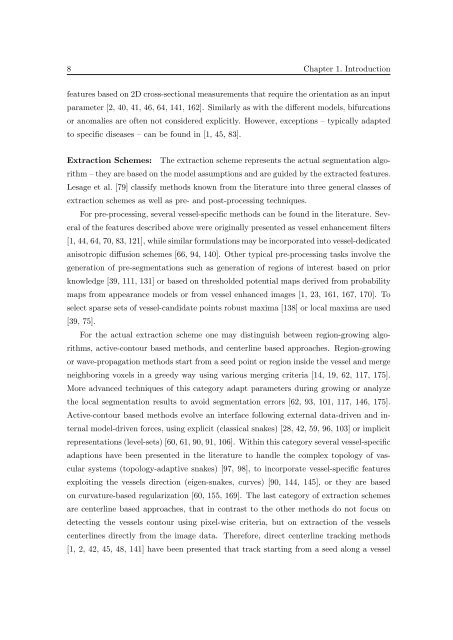Segmentation of 3D Tubular Tree Structures in Medical Images ...
Segmentation of 3D Tubular Tree Structures in Medical Images ...
Segmentation of 3D Tubular Tree Structures in Medical Images ...
You also want an ePaper? Increase the reach of your titles
YUMPU automatically turns print PDFs into web optimized ePapers that Google loves.
8 Chapter 1. Introduction<br />
features based on 2D cross-sectional measurements that require the orientation as an <strong>in</strong>put<br />
parameter [2, 40, 41, 46, 64, 141, 162]. Similarly as with the different models, bifurcations<br />
or anomalies are <strong>of</strong>ten not considered explicitly. However, exceptions – typically adapted<br />
to specific diseases – can be found <strong>in</strong> [1, 45, 83].<br />
Extraction Schemes: The extraction scheme represents the actual segmentation algorithm<br />
– they are based on the model assumptions and are guided by the extracted features.<br />
Lesage et al. [79] classify methods known from the literature <strong>in</strong>to three general classes <strong>of</strong><br />
extraction schemes as well as pre- and post-process<strong>in</strong>g techniques.<br />
For pre-process<strong>in</strong>g, several vessel-specific methods can be found <strong>in</strong> the literature. Several<br />
<strong>of</strong> the features described above were orig<strong>in</strong>ally presented as vessel enhancement filters<br />
[1, 44, 64, 70, 83, 121], while similar formulations may be <strong>in</strong>corporated <strong>in</strong>to vessel-dedicated<br />
anisotropic diffusion schemes [66, 94, 140]. Other typical pre-process<strong>in</strong>g tasks <strong>in</strong>volve the<br />
generation <strong>of</strong> pre-segmentations such as generation <strong>of</strong> regions <strong>of</strong> <strong>in</strong>terest based on prior<br />
knowledge [39, 111, 131] or based on thresholded potential maps derived from probability<br />
maps from appearance models or from vessel enhanced images [1, 23, 161, 167, 170]. To<br />
select sparse sets <strong>of</strong> vessel-candidate po<strong>in</strong>ts robust maxima [138] or local maxima are used<br />
[39, 75].<br />
For the actual extraction scheme one may dist<strong>in</strong>guish between region-grow<strong>in</strong>g algorithms,<br />
active-contour based methods, and centerl<strong>in</strong>e based approaches. Region-grow<strong>in</strong>g<br />
or wave-propagation methods start from a seed po<strong>in</strong>t or region <strong>in</strong>side the vessel and merge<br />
neighbor<strong>in</strong>g voxels <strong>in</strong> a greedy way us<strong>in</strong>g various merg<strong>in</strong>g criteria [14, 19, 62, 117, 175].<br />
More advanced techniques <strong>of</strong> this category adapt parameters dur<strong>in</strong>g grow<strong>in</strong>g or analyze<br />
the local segmentation results to avoid segmentation errors [62, 93, 101, 117, 146, 175].<br />
Active-contour based methods evolve an <strong>in</strong>terface follow<strong>in</strong>g external data-driven and <strong>in</strong>ternal<br />
model-driven forces, us<strong>in</strong>g explicit (classical snakes) [28, 42, 59, 96, 103] or implicit<br />
representations (level-sets) [60, 61, 90, 91, 106]. With<strong>in</strong> this category several vessel-specific<br />
adaptions have been presented <strong>in</strong> the literature to handle the complex topology <strong>of</strong> vascular<br />
systems (topology-adaptive snakes) [97, 98], to <strong>in</strong>corporate vessel-specific features<br />
exploit<strong>in</strong>g the vessels direction (eigen-snakes, curves) [90, 144, 145], or they are based<br />
on curvature-based regularization [60, 155, 169]. The last category <strong>of</strong> extraction schemes<br />
are centerl<strong>in</strong>e based approaches, that <strong>in</strong> contrast to the other methods do not focus on<br />
detect<strong>in</strong>g the vessels contour us<strong>in</strong>g pixel-wise criteria, but on extraction <strong>of</strong> the vessels<br />
centerl<strong>in</strong>es directly from the image data. Therefore, direct centerl<strong>in</strong>e track<strong>in</strong>g methods<br />
[1, 2, 42, 45, 48, 141] have been presented that track start<strong>in</strong>g from a seed along a vessel















